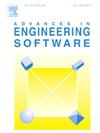Dimensionality reduction of solution reconstruction methods for a four-point stencil
IF 4
2区 工程技术
Q2 COMPUTER SCIENCE, INTERDISCIPLINARY APPLICATIONS
引用次数: 0
Abstract
The development of reconstruction methods has faced considerable challenges due to their inherent high dimensionality. In the present study, an innovative dimensionality reduction method aimed at mitigating these challenges by normalizing flow variables is proposed. Through our investigation, we demonstrate that a reconstruction method, specifically designed for a four-point stencil that is compatible with unstructured meshes, can be effectively represented by six two-dimensional functions. This key insight enables us to devise a visualization technique utilizing a single contour plot for the reconstruction method. Additionally, we establish that a single data set can adequately represent the reconstruction method, facilitating solution reconstruction through data set interpolation. By carefully evaluating the interpolation error, a data set of reasonable size yields sufficiently small interpolation errors. Notably, we uncover the possibility of extracting reconstruction methods from a trained artificial neural network (ANN). To gauge the impact of accumulated interpolation errors on solution quality, we conduct comprehensive analyses on four benchmark problems. Our results demonstrate that with a data set of sufficient size, the accumulated interpolation error becomes negligible, rendering the solution reconstruction by interpolating the extracted data set both accurate and cost-effective. The implications of our findings hold substantial promise for enhancing the efficiency and efficacy of reconstruction methods.
四点模版求解重构方法的降维问题
由于其固有的高维性,重建方法的开发面临着相当大的挑战。本研究提出了一种创新的降维方法,旨在通过对流动变量进行归一化来缓解这些挑战。通过研究,我们证明了一种专为四点模版设计的重构方法可以有效地用六个二维函数来表示,该方法与非结构网格兼容。这一重要见解使我们能够设计出一种可视化技术,利用单一等高线图来表示重建方法。此外,我们还确定了单个数据集可充分代表重建方法,从而通过数据集插值促进解的重建。通过仔细评估插值误差,合理大小的数据集可产生足够小的插值误差。值得注意的是,我们发现了从训练有素的人工神经网络(ANN)中提取重构方法的可能性。为了衡量累积插值误差对求解质量的影响,我们对四个基准问题进行了全面分析。我们的结果表明,只要数据集足够大,累积插值误差就可以忽略不计,从而使通过对提取的数据集进行插值来重构解决方案既准确又经济。我们的研究结果为提高重构方法的效率和效力带来了巨大希望。
本文章由计算机程序翻译,如有差异,请以英文原文为准。
求助全文
约1分钟内获得全文
求助全文
来源期刊

Advances in Engineering Software
工程技术-计算机:跨学科应用
CiteScore
7.70
自引率
4.20%
发文量
169
审稿时长
37 days
期刊介绍:
The objective of this journal is to communicate recent and projected advances in computer-based engineering techniques. The fields covered include mechanical, aerospace, civil and environmental engineering, with an emphasis on research and development leading to practical problem-solving.
The scope of the journal includes:
• Innovative computational strategies and numerical algorithms for large-scale engineering problems
• Analysis and simulation techniques and systems
• Model and mesh generation
• Control of the accuracy, stability and efficiency of computational process
• Exploitation of new computing environments (eg distributed hetergeneous and collaborative computing)
• Advanced visualization techniques, virtual environments and prototyping
• Applications of AI, knowledge-based systems, computational intelligence, including fuzzy logic, neural networks and evolutionary computations
• Application of object-oriented technology to engineering problems
• Intelligent human computer interfaces
• Design automation, multidisciplinary design and optimization
• CAD, CAE and integrated process and product development systems
• Quality and reliability.
 求助内容:
求助内容: 应助结果提醒方式:
应助结果提醒方式:


